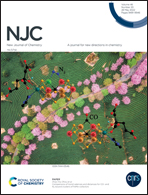Solvent-assisted preparation of low-temperature SnO2 electron transport layers for efficient and stable perovskite solar cells made in ambient conditions†
Abstract
In terms of high electron mobility and good stability, the SnO2 based electron transport layer (ETL) is favored by uncountable researchers. However, how to reduce the surface defects and improve the crystalline quality of the SnO2 ETL during low-temperature preparation is still a great challenge. Here, we develop a brief solvothermal synthesis method to prepare a SnO2 ETL with high quality at a low temperature, in which a mixed solution of ethanol and water is chosen as the solvent to enhance the crystallinity of SnO2. Notably, the preparation of the SnO2 ETL only requires annealing at 85 °C, which efficiently promotes process simplification and cost savings. Based on the fluorine-doped tin oxide (FTO)/SnO2/perovskite/Spiro-OMeTAD/Au structure, the champion device has a power conversion efficiency (PCE) of up to 19.21% with low hysteresis. The unencapsulated device can maintain more than 93% of its original efficiency after 1440 h in an atmospheric environment, and its initial efficiency is only reduced by about 9% after heating at 85 °C for 24 h, showing good long-term stability and good thermal stability. Importantly, the assembly and testing of the devices are done in an atmospheric environment, which provides a new route to the preparation of high-performance SnO2-based perovskite solar cells (PSCs) in the air.



 Please wait while we load your content...
Please wait while we load your content...